
НОРДИМЕТ 12,5 мг раствор для инъекций в предварительно заполненной шприц-ручке

Инструкция по применению НОРДИМЕТ 12,5 мг раствор для инъекций в предварительно заполненной шприц-ручке
Введение
Прошпект: информация для пользователя
Нордимет 7,5 мг раствор для инъекций в предварительно заполненном шприце
Нордимет 10 мг раствор для инъекций в предварительно заполненном шприце
Нордимет 12,5 мг раствор для инъекций в предварительно заполненном шприце
Нордимет 15 мг раствор для инъекций в предварительно заполненном шприце
Нордимет 17,5 мг раствор для инъекций в предварительно заполненном шприце
Нордимет 20 мг раствор для инъекций в предварительно заполненном шприце
Нордимет 22,5 мг раствор для инъекций в предварительно заполненном шприце
Нордимет 25 мг раствор для инъекций в предварительно заполненном шприце
метотрексат
Прочитайте внимательно весь прошпект перед началом использования этого лекарства, поскольку он содержит важную информацию для вас.
- Сохраните этот прошпект, поскольку вам может потребоваться снова прочитать его.
- Если у вас есть какие-либо вопросы, проконсультируйтесь с вашим врачом или фармацевтом.
- Это лекарство было назначено только вам, и не следует давать его другим людям, даже если у них такие же симптомы, как у вас, поскольку оно может нанести им вред.
- Если вы испытываете побочные эффекты, проконсультируйтесь с вашим врачом или фармацевтом, даже если это побочные эффекты, которые не указаны в этом прошпекте. См. раздел 4.
Содержание прошпекта
- Что такое Нордимет и для чего он используется
- Что вам нужно знать перед началом использования Нордимета
- Как использовать Нордимет
- Возможные побочные эффекты
- Хранение Нордимета
- Содержание упаковки и дополнительная информация
1. Что такое Нордимет и для чего он используется
Нордимет содержит активное вещество метотрексат, которое:
- уменьшает воспаление или отек, и
- уменьшает активность иммунной системы (собственный механизм защиты организма). Была обнаружена связь между гиперактивной иммунной системой и воспалительными заболеваниями.
Нордимет является лекарством, используемым для лечения различных воспалительных заболеваний:
- активный ревматоидный артрит у взрослых. Активный ревматоидный артрит является воспалительным заболеванием, поражающим суставы.
- тяжелый активный ювенильный идиопатический артрит в пяти или более суставах (поэтому это расстройство называется полиартрит), у пациентов, которые показали недостаточную реакцию на нестероидные противовоспалительные препараты (НПВП).
- псориаз в пластинках средней и тяжелой степени у взрослых, кандидатов на системное лечение, а также тяжелый псориаз, который также поражает суставы (псориатический артрит) у взрослых пациентов.
- индукция ремиссии у взрослых с умеренной зависимостью от кортикостероидов болезнью Крона, в комбинации с кортикостероидами.
- поддержание ремиссии болезни Крона у взрослых, которые ответили на метотрексат, в монотерапии.
2. Что вам нужно знать перед началом использования Нордимета
Не используйте Нордимет, если:
- у вас есть аллергия на метотрексат или на любой другой компонент этого лекарства (включая раздел 6).
- у вас есть тяжелая нефропатия (ваш врач может сказать вам, если у вас есть тяжелая нефропатия).
- у вас есть тяжелое заболевание печени (ваш врач может сказать вам, если у вас есть тяжелое заболевание печени).
- у вас есть расстройства системы кроветворения.
- у вас есть высокий уровень потребления алкоголя.
- у вас есть ослабленная иммунная система.
- у вас есть тяжелая инфекция или существующая инфекция, например, туберкулез или ВИЧ.
- у вас есть язвы желудочно-кишечного тракта.
- вы беременны или в период лактации (см. раздел «Беременность, лактация и фертильность»).
- вы получаете вакцины с живыми микроорганизмами одновременно.
Предостережения и меры предосторожности
Были сообщения о метотрексате острого легочного кровотечения у пациентов с основным ревматологическим заболеванием. Если вы наблюдаете кровь при кашле или отхаркивании, вам следует немедленно обратиться к вашему врачу.
Может произойти увеличение размера лимфатических узлов (лимфома), в этом случае необходимо прервать лечение.
Диарея может быть токсическим эффектом Нордимета и требует прерывания лечения.
Если у вас есть диарея, поговорите с вашим врачом.
Были сообщения о определенных расстройствах мозга (энцефалопатия/леукоэнцефалопатия) у пациентов с раком, получающих метотрексат. Эти побочные эффекты не могут быть исключены, когда метотрексат используется для лечения других заболеваний.
Если вы, ваш партнер или ваш опекун заметили появление или ухудшение неврологических симптомов, таких как общая мышечная слабость, нарушения зрения, изменения в мышлении, памяти и ориентации, вызывающие путаницу, и изменения в личности, немедленно обратитесь к вашему врачу, поскольку эти могут быть симптомами редкого тяжелого церебрального заболевания, называемого прогрессивной мультифокальной лейкоэнцефалопатией (ПМЛ).
Метотрексат может сделать кожу более чувствительной к солнечному свету. Избегайте интенсивного солнечного света и не используйте солнечные лампы или ультрафиолетовые лампы без консультации с врачом. Чтобы защитить кожу от интенсивного солнечного света, носите подходящую одежду или используйте солнцезащитный крем с высоким фактором защиты.
Важное предупреждение об использовании Нордимета
Метотрексат следует использовать только для лечения ревматологических, кожных и заболеваний Крона один раз в неделю. Неправильное использование метотрексата может привести к тяжелым побочным эффектам, которые могут быть смертельными. Внимательно прочитайте раздел 3 этого прошпекта.
Проконсультируйтесь с вашим врачом перед началом использования Нордимета, если:
- у вас есть сахарный диабет и вы получаете инсулин;
- у вас есть длительные неактивные инфекции (например, туберкулез, гепатит Б или С, опоясывающий герпес);
- у вас есть/было какое-либо заболевание печени или нефропатия;
- у вас есть проблемы с функцией легких;
- у вас есть тяжелый ожирение;
- у вас есть аномальное накопление жидкости в брюшной полости или в полости между легкими и грудной стенкой (асцит, плевральные выпоты);
- вы обезвожены или имеете расстройство, которое приводит к обезвоживанию (например, обезвоживание в результате рвоты, диареи или воспаления рта и губ).
Если у вас были проблемы с кожей после радиотерапии (радиационная дерматит) или ожоги кожи, эти изменения могут повториться при приеме Нордимета.
Дети, подростки и пациенты пожилого возраста
Инструкции по дозировке зависят от веса тела пациента.
Не рекомендуется использовать у детей младше 3 лет из-за недостаточного опыта использования этого лекарства в этой возрастной группе.
Дети, подростки и пациенты пожилого возраста, леченные Нордиметом, должны находиться под близким медицинским наблюдением для выявления возможных побочных эффектов как можно скорее.
Дозировка для пациентов пожилого возраста должна быть снижена из-за снижения функции печени и почек, связанного с возрастом.
Особые меры предосторожности для лечения Нордиметом
Метотрексат временно влияет на сперму и производство яиц. Метотрексат может вызвать выкидыши и тяжелые врожденные дефекты. Если вы женщина, вам следует избегать беременности, если вы принимаете метотрексат в это время и в течение как минимум 6 месяцев после окончания лечения метотрексатом. Если вы мужчина, вам следует избегать зачатия ребенка, если вы принимаете метотрексат в это время и в течение как минимум 3 месяцев после окончания лечения.
Прочитайте также раздел «Беременность, лактация и фертильность».
Изменения кожи, вызванные псориазом, могут ухудшиться во время лечения Нордиметом в случае воздействия ультрафиолетового излучения.
Рекомендуемые меры предосторожности и наблюдения
Даже при использовании метотрексата в низких дозах могут возникнуть тяжелые побочные эффекты. Чтобы обнаружить их вовремя, ваш врач будет проводить контрольные обследования и лабораторные тесты.
До начала лечения:
До начала лечения у вас будет сделан анализ крови, чтобы определить, достаточно ли у вас кровяных клеток. Также у вас будет сделан анализ крови, чтобы проверить функцию печени и обнаружить, есть ли у вас гепатит. Кроме того, будут проверены уровни сывороточного альбумина (белка крови), состояние гепатита (инфекция печени) и функция почек. Врач также может решить провести другие тесты на печень, которые могут включать получение изображений печени или взятие небольшой пробы ткани печени для более тщательного обследования. Также возможно, что врач проверит, есть ли у вас туберкулез, и сделает рентгенографию грудной клетки или тест на функцию легких.
Во время лечения:
Врач может провести следующие обследования:
- Обследование полости рта и горла, чтобы обнаружить изменения в слизистой оболочке, такие как воспаление или язвы.
- Анализ крови/гемограмма с подсчетом кровяных клеток и измерением уровней метотрексата в сыворотке.
- Анализ крови, чтобы контролировать функцию печени.
- Тесты на изображения, чтобы контролировать состояние печени.
- Взятие небольшой пробы ткани печени для более тщательного обследования.
- Анализ крови, чтобы контролировать функцию почек.
- Контроль дыхательных путей и, если необходимо, тест на функцию легких.
Очень важно, чтобы вы прошли эти запланированные обследования.
Если результаты некоторых из этих тестов являются аномальными, ваш врач отрегулирует лечение соответственно.
Другие лекарства и Нордимет
Сообщите вашему врачу или фармацевту, если вы принимаете, недавно принимали или можете принять любое другое лекарство.
Особенно важно, чтобы вы сообщили вашему врачу, если вы принимаете:
- другие методы лечения ревматоидного артрита или псориаза, такие как лефлуномид, сульфасалазин (лекарство, которое, кроме артрита и псориаза, также используется для лечения язвенного колита), ацетилсалициловую кислоту, фенилбутазон или амидопирин;
- циклоспорин (для подавления иммунной системы);
- азатиоприн (используется для предотвращения отторжения после трансплантации органов);
- ретиноиды (используются для лечения псориаза и других кожных расстройств);
- противоэпилептические препараты (используются для предотвращения приступов), такие как фенитоин, валпроат или карбамазепин;
- лечение рака;
- барбитураты (инъекция для сна);
- транквилизаторы;
- оральные контрацептивы;
- пробенецид (используется для лечения подагры);
- антибиотики (например, пенициллин, глюкопептиды, триметоприм-сульфаметоксазол, сульфонамиды, ципрофлоксацин, цефалотин, тетрациклины, хлорамфеникол);
- пириметамин (используется для профилактики и лечения малярии);
- витаминные препараты с фолиевой кислотой;
- ингибиторы протонной помпы (лекарства, которые снижают производство желудочной кислоты и используются для лечения изжоги или тяжелых язв), такие как омепразол или пантопразол;
- теофиллин (используется для лечения астмы);
- холестирамин (используется для лечения высокого уровня холестерина, зуда или диареи);
- НПВП, нестероидные противовоспалительные препараты (используются для лечения боли или воспаления);
- п-аминобензойная кислота (используется для лечения кожных расстройств);
- любую вакцину с живыми микроорганизмами (следует избегать), такую как вакцины против кори, свинки, гриппа и желтой лихорадки;
- метамизол (синонимы: новаминсульфон и дипирон) (лекарство для сильной боли и/или лихорадки);
- оксид азота (газ, используемый в общей анестезии)
Нордимет с продуктами питания, напитками и алкоголем
Во время лечения Нордиметом следует избегать потребления алкоголя и чрезмерного потребления кофе, газированных напитков, содержащих кофеин, и черного чая, поскольку они могут увеличить побочные эффекты или влиять на эффективность Нордимета. Также убедитесь, что вы пьете много жидкости во время лечения Нордиметом, поскольку обезвоживание (снижение количества воды в организме) может увеличить токсичность Нордимета.
Беременность, лактация и фертильность
Если вы беременны или в период лактации, считаете, что можете быть беременной или планируете стать беременной, проконсультируйтесь с вашим врачом перед использованием этого лекарства.
Беременность
Не используйте Нордимет во время беременности или если вы пытаетесь стать беременной. Метотрексат может вызвать врожденные дефекты, нанести вред плоду или привести к выкидышу. Он ассоциируется с аномалиями развития черепа, лица, сердца и сосудов, мозга и конечностей. Поэтому очень важно, чтобы метотрексат не назначался беременным женщинам или тем, кто планирует стать беременным. У женщин детородного возраста должна быть исключена любая возможность беременности с помощью соответствующих мер, например, теста на беременность, перед началом лечения. Вам следует избегать беременности, пока вы принимаете метотрексат, и в течение как минимум 6 месяцев после окончания лечения, используя надежные методы контрацепции в течение этого времени (см. также раздел «Предостережения и меры предосторожности»).
Если вы становитесь беременной во время лечения или подозреваете, что можете быть беременной, поговорите с вашим врачом как можно скорее. Им следует рассказать вам о риске вредного воздействия на плод во время лечения.
Если вы хотите стать беременной, проконсультируйтесь с вашим врачом, который может направить вас к специалисту до предполагаемого начала лечения.
Лактация
Не кормите грудью во время лечения, поскольку метотрексат проникает в грудное молоко. Если врач считает, что лечение метотрексатом абсолютно необходимо во время лактации, вам следует прекратить кормить грудью.
Мужская фертильность
Доступные данные не указывают на повышенный риск дефектов или выкидышей, если отец принимает менее 30 мг/неделю метотрексата. Однако нельзя полностью исключить определенный риск. Метотрексат может быть генотоксичным. Это означает, что лекарство может вызывать генетические мутации. Метотрексат может влиять на производство спермы и вызывать врожденные дефекты. По этой причине вам следует избегать зачатия ребенка или донорства спермы, пока вы принимаете метотрексат, и в течение как минимум 3 месяцев после окончания лечения.
Вождение и использование машин
Могут возникнуть побочные эффекты, влияющие на центральную нервную систему, такие как усталость и головокружение, во время лечения Нордиметом. В некоторых случаях способность управлять транспортными средствами и/или использовать машины может быть снижена. Если вы чувствуете усталость или головокружение, не следует управлять транспортными средствами или использовать машины.
Нордимет содержит натрий
Это лекарство содержит менее 1 ммоль (23 мг) натрия на дозу, что означает, что оно практически «не содержит натрия».
3. Как использовать Нордимет
Важное предупреждение о дозировке Нордимета
Используйте Нордимет только один раз в неделюдля лечения ревматоидного артрита, активной ювенильной идиопатической артрита, псориаза, псориатического артрита и болезни Крона, которые требуют еженедельного введения. Чрезмерное использование Нордимета может быть смертельным. Внимательно прочитайте раздел 3 этого листка инструкции. Если у вас есть какие-либо сомнения, проконсультируйтесь с вашим врачом или фармацевтом перед приемом этого лекарства.
Следуйте точно инструкциям по введению этого лекарства, указанным вашим врачом. В случае сомнений проконсультируйтесь снова с вашим врачом или фармацевтом.
Нордимет вводится только один раз в неделю. Вы и ваш врач можете согласовать, в какой день недели вы будете получать инъекцию каждую неделю.
Неправильное введение Нордимета может привести к серьезным побочным эффектам, которые могут быть смертельными.
Рекомендуемая доза:
Доза для пациентов с ревматоидным артритом
Рекомендуемая начальная доза составляет 7,5 мг метотрексата один раз в неделю.
Врач может увеличить дозу, если используемая доза неэффективна, но хорошо переносится. Средняя еженедельная доза составляет 15-20 мг. Обычно не следует превышать еженедельную дозу 25 мг. Когда Нордимет начнет действовать, врач может постепенно снизить дозу до минимально эффективной поддерживающей дозы.
Обычно улучшение симптомов ожидается после 4-8 недель лечения. Симптомы могут вернуться, если лечение Нордиметом будет прервано.
Использование у взрослых с умеренным или тяжелым псориазом или тяжелым псориатическим артритом
Ваш врач введет вам пробную дозу 5-10 мг для оценки возможных побочных эффектов.
Если пробная доза хорошо переносится, лечение будет продолжено через неделю с приблизительной дозой 7,5 мг.
Обычно можно ожидать ответ на лечение после примерно 2-6 недель. В зависимости от эффектов лечения и результатов анализов крови и мочи, лечение будет продолжено или прервано.
Доза для взрослых пациентов с болезнью Крона
Ваш врач начнет лечение с еженедельной дозы 25 мг. Обычно можно ожидать ответ на лечение после 8-12 недель. В зависимости от эффектов лечения, ваш врач может решить снизить дозу до 15 мг в неделю.
Использование у детей и подростков младше 16 лет с полиартикулярными формами ювенильного идиопатического артрита
Врач рассчитает необходимую дозу на основе площади поверхности тела ребенка (м2), и доза выражается в мг/м2.
Использование у детей младше 3 лет не рекомендуется, поскольку нет достаточного опыта использования в этой возрастной группе.
Метод и продолжительность введения
Нордимет вводится путем подкожной инъекции. Его следует вводить один раз в неделю, и рекомендуется вводить Нордимет всегда в один и тот же день недели.
В начале вашего лечения врач может вводить Нордимет лично. Однако ваш врач может решить, что вы сами должны научиться вводить Нордимет. Вы получите соответствующую подготовку для этого. Никогда не пытайтесь самоинъекции, если вам не показали, как это делать.
Продолжительность лечения будет определена врачом, ответственным за лечение. Лечение ревматоидного артрита, ювенильного идиопатического артрита, псориаза, псориатического артрита и болезни Крона Нордиметом является долгосрочным лечением.
Информация о том, как вводить Нордимет самостоятельно
Если у вас возникли трудности с обращением с ручкой, проконсультируйтесь с вашим врачом или фармацевтом. Не пытайтесь самоинъекции, если вам не показали, как это делать. Если вы не уверены, проконсультируйтесь с вашим врачом или медсестрой немедленно.
Перед самоинъекцией Нордимета
- Проверьте срок годности лекарства. Не используйте его, если он истек.
- Проверьте, что ручка не повреждена и что лекарство представляет собой прозрачный желтоватый раствор. В противном случае используйте другую ручку.
- Осмотрите место последней инъекции, чтобы проверить, не вызвало ли оно покраснение, изменение цвета кожи, отек или гноя, или если оно все еще болит. В этом случае проконсультируйтесь с вашим врачом или медсестрой.
- Решите, где вы введете лекарство. Меняйте место, где вы самоинъекцируете лекарство, каждый раз.
Инструкции по самоинъекции Нордимета
- Тщательно вымойте руки водой и мылом.
- Сядьте или лягте в удобном и расслабленном положении. Убедитесь, что вы можете видеть область кожи, где будете делать инъекцию.
- Ручка предварительно заполнена и готова к использованию. Визуально осмотрите ручку. Вы должны увидеть желтоватый раствор через смотровое окно. Возможно, вы увидите небольшую пузырек воздуха, это не повлияет на инъекцию и не причинит вам вреда.
Может появиться капля на конце иглы. Это нормально.
- Выберите место инъекции и очистите его тампоном, пропитанным спиртом, который прилагается. Это действует в течение 30-60 секунд. Подходящими зонами для инъекции являются кожа передней части брюшной стенки и кожа передней части бедра.
- Пока держите корпус ручки, снимите защитный колпачок, потянув его плавно и прямо из устройства. Не поворачивайте его и не сгибайте.
После снятия колпачка держите ручку в руке. Избегайте контакта ручки с любыми другими предметами. Это позволяет обеспечить, чтобы ручка не активировалась случайно и чтобы игла оставалась чистой.
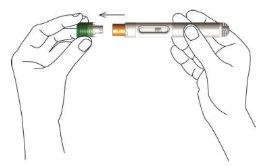
- Сформируйте складку на коже, слегка защипнув кожу в месте инъекции большим и указательным пальцами. Убедитесь, что вы держите складку кожи во время всей инъекции.
- Переместите ручку к складке кожи (месту инъекции) с защитным колпачком иглы, указывающим直接 на место инъекции. Поместите желтый защитник иглы против зоны инъекции, так чтобы весь край защитника иглы был в контакте с кожей.
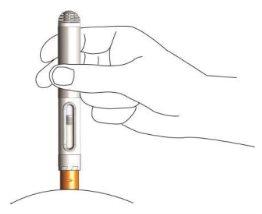
- Примените давление вниз на ручку на коже до тех пор, пока вы не услышите и не почувствуете щелчок.
Таким образом, ручка активируется, и раствор будет автоматически введен в кожу.
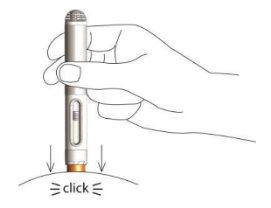
- Инъекция длится не более 10 секунд. Вы заметите и услышите второй щелчок, когда инъекция будет завершена.
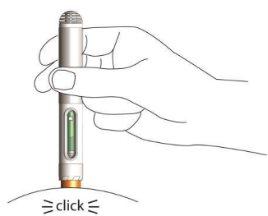
- Подождите 2-3 секунды больше, прежде чем удалить ручку из кожи. Защитный механизм ручки блокируется, чтобы предотвратить травмы от уколов иглы. Теперь вы можете отпустить складку кожи.
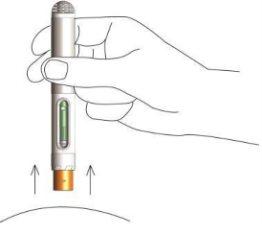
- Визуально осмотрите ручку через смотровое окно. Вы должны увидеть зеленый пластик. Это означает, что весь раствор был введен. Утилизируйте использованную ручку в контейнере для острых предметов, поставляемом с ручкой. Закройте контейнер плотно и держите его вне досягаемости детей. В случае случайного контакта метотрексата с кожей или мягкими тканями, промойте пораженную область большим количеством воды.
Если вы использовали больше Нордимета, чем следует
Следуйте рекомендациям по дозировке врача, ответственного за лечение. Не меняйте дозу без консультации с вашим врачом.
Если вы подозреваете, что использовали больше Нордимета, чем следует, сообщите об этом вашему врачу или немедленно обратитесь в ближайшую больницу. Принесите упаковку лекарства и этот листок инструкции к врачу или в больницу.
Передозировка метотрексата может привести к серьезным токсическим реакциям. Симптомы передозировки могут включать быстрое образование гематом или кровотечения, необычную слабость, язвы во рту, тошноту, рвоту, черные или кровянистые испражнения, кашель с кровью или рвоту с видом кофейной гущи и уменьшение мочеиспускания (опорожнения мочевого пузыря). См. также раздел 4.
Если вы забыли использовать Нордимет
Не используйте двойную дозу, чтобы компенсировать пропущенные дозы, но продолжайте использовать назначенную дозу в обычном порядке. Проконсультируйтесь с вашим врачом, если у вас есть сомнения.
Если вы прервете лечение Нордиметом
Не должны прерывать или прекращать лечение Нордиметом до обсуждения этого с вашим врачом. Если вы подозреваете, что испытываете побочные эффекты, немедленно проконсультируйтесь с вашим врачом.
Если у вас есть какие-либо другие вопросы о использовании этого лекарства, проконсультируйтесь с вашим врачом или фармацевтом.
4. Возможные побочные эффекты
Как и все лекарства, это лекарство может вызывать побочные эффекты, хотя не все люди испытывают их.
Сообщите вашему врачу, если вы испытываете внезапное головокружение, трудности с дыханием, отек век, лица или губ, сыпь или зуд (который особенно поражает все тело).
Серьезные побочные эффекты
Если вы разовьете любой из следующих побочных эффектов, немедленно свяжитесь с вашим врачом:
- Воспаление легких (симптомы могут быть общим заболеванием, сухим и раздражающим кашлем, трудностями с дыханием, одышкой в покое, болью в груди или лихорадкой).
- Кровь при кашле или откашливании.
- Сильная эксфолиация или пузыри на коже.
- Кровотечения (включая кровь в рвоте) или необычное образование гематом.
- Сильная диарея.
- Язвы во рту.
- Черные или дегтеобразные испражнения.
- Кровь в моче или испражнениях.
- Красные точки на коже.
- Лихорадка.
- Желтуха кожи (желтуха).
- Боль и трудности с мочеиспусканием.
- Жажда и/или частое мочеиспускание.
- Припадки (судороги).
- Потеря сознания.
- Потеря зрения или размытое зрение.
Следующие побочные эффекты были зарегистрированы:
Очень часто(могут поражать более 1 из 10 человек)
Потеря аппетита, тошнота (желание рвоты), боль в желудке, воспаление слизистой оболочки рта, нарушение пищеварения и увеличение печеночных ферментов.
Часто(могут поражать до 1 из 10 человек)
Уменьшение образования красных кровяных телец (гематокрита) с уменьшением количества белых кровяных телец (лейкоцитов) и/или красных кровяных телец и/или тромбоцитов (тромбоцитопения), головная боль, усталость, сонливость, воспаление легких (пневмония) с сухим кашлем и лихорадкой, язвы во рту, диарея, сыпь, покраснение кожи и зуд.
Не часто(могут поражать до 1 из 100 человек)
Уменьшение количества определенных лейкоцитов, воспаление горла, головокружение, замешательство, депрессия, воспаление кровеносных сосудов, язвы и кровотечения в желудочно-кишечном тракте, воспаление кишечника, рвота, воспаление поджелудочной железы, нарушения функции печени, диабет, уменьшение белков крови, сыпь, подобная герпесу, раздражение кожи, реакции, подобные солнечным ожогам, выпадение волос, увеличение ревматоидных узлов, кожные язвы, опоясывающий герпес, боль в суставах или мышцах, остеопороз (уменьшение плотности костей), воспаление и язвы мочевого пузыря (возможно, с кровью в моче), уменьшение функции почек, больное мочеиспускание, воспаление и язвы влагалища.
Редко(могут поражать до 1 из 1000 человек)
Инфекция (включая реактивацию хронической неактивной инфекции), сепсис, покраснение глаз, аллергические реакции, анафилактический шок, уменьшение количества антител в крови, воспаление перикарда, накопление жидкости в перикарде, нарушение сердечного наполнения из-за наличия жидкости в перикарде, нарушения зрения, колебания настроения, низкое кровяное давление, тромбы, образование рубцовой ткани в легких (пульмонная фиброз), пневмония, вызванная Pneumocystis jirovecii, остановка дыхания, астма, накопление жидкости в плевре, воспаление десен, острый гепатит (воспаление печени), потемнение кожи, акне, красные или фиолетовые точки из-за кровотечения в сосудах, аллергическое воспаление кровеносных сосудов, перелом кости, почечная недостаточность, уменьшение или отсутствие мочи, нарушения электролитного баланса, лихорадка, медленное заживление ран.
Очень редко(могут поражать до 1 из 10 000 человек)
Уменьшение количества определенных лейкоцитов (агранулоцитоз), тяжелая недостаточность костного мозга, тяжелая недостаточность печени, воспаление желез, бессонница, боль, мышечная слабость, онемение или покалывание/уменьшение чувствительности, изменения вкуса (металлический вкус), судороги, воспаление оболочки мозга с параличом или рвотой, нарушение зрения, повреждение сетчатки, рвота с кровью, токсический мегаколон (расширение толстой кишки, связанное с сильной болью), дефектное образование спермы (олигоспермия), синдром Стивенса-Джонсона, токсический эпидермальный некролиз (синдром Лайелла), увеличение пигментации ногтей, потеря либидо, проблемы с эрекцией, инфекция вокруг ногтей, серьезные осложнения желудочно-кишечного тракта, фурункулы, видимое увеличение мелких кровеносных сосудов кожи, нарушения менструального цикла, вагинальные выделения, бесплодие, гинекомастия у мужчин и лимфопролиферативные расстройства (чрезмерный рост белых кровяных телец).
Частота не известна(не может быть оценена на основе доступных данных)
Увеличение количества определенных белых кровяных телец (эозинофилия), определенные церебральные расстройства (энцефалопатия/леукоэнцефалопатия), носовые кровотечения, легочное кровотечение, повреждение костей челюсти (вторичное по отношению к чрезмерному росту белых кровяных телец), белок в моче, чувство слабости, разрушение ткани в месте инъекции, покраснение и шелушение кожи, воспаление.
Были обнаружены только легкие местные кожные реакции (такие как ощущения жжения, эритема, отек, изменение цвета, сильный зуд и боль) с Нордиметом, которые уменьшались во время лечения.
Нордимет может вызывать уменьшение количества лейкоцитов и, возможно, уменьшит вашу устойчивость к инфекциям. Если вы испытываете инфекцию с симптомами, такими как лихорадка и значительное ухудшение общего состояния, или лихорадка с симптомами местной инфекции, такими как боль в горле/фаринге/полости рта, или проблемы с мочеиспусканием, немедленно проконсультируйтесь с вашим врачом. Вам сделают анализ крови, чтобы проверить возможное уменьшение количества лейкоцитов (агранулоцитоз). Важно сообщить вашему врачу, если вы принимаете Нордимет.
Известно, что метотрексат вызывает костные расстройства, такие как боль в суставах и мышцах, и остеопороз. Неизвестна частота этих рисков у детей.
Нордимет может вызывать серьезные побочные эффекты (в некоторых случаях потенциально смертельные). Ваш врач проведет тесты, чтобы проверить аномалии, которые могут развиться в крови (например, низкий уровень лейкоцитов, низкий уровень тромбоцитов, лимфома) и изменения в почках и печени.
Сообщение о побочных эффектах
Если вы испытываете любой побочный эффект, проконсультируйтесь с вашим врачом или фармацевтом, даже если это побочные эффекты, которые не перечислены в этом листке инструкции. Вы также можете сообщить об этом напрямую через национальную систему уведомления, включенную в приложение V. Сообщая о побочных эффектах, вы можете способствовать предоставлению более полной информации о безопасности этого лекарства.
5. Хранение Нордимета
Храните это лекарство в недоступном для детей месте.
Не используйте это лекарство после срока годности, указанного на этикетке предварительно заполненной ручки и на коробке после «Срок годности». Срок годности - последний день месяца, указанного.
Храните при температуре ниже 25°C.
Храните ручку в наружной упаковке, чтобы защитить ее от света.
Не замораживайте.
Не используйте это лекарство, если вы заметили, что раствор не прозрачный или содержит частицы.
Нордимет предназначен для одноразового использования. Любую использованную ручку следует утилизировать. Лекарства не должны выбрасываться в канализацию или мусор. Спросите вашего фармацевта, как утилизировать упаковку и лекарства, которые вам больше не нужны. Таким образом, вы поможете защитить окружающую среду.
6. Содержание упаковки и дополнительная информация
Состав Нордимета
Активное вещество - метотрексат. 1,0 мл раствора содержит 25 мг метотрексата.
Другие компоненты - хлорид натрия, гидроксид натрия и вода для инъекционных препаратов.
Доступны следующие шприцы:
Предварительно заполненный шприц объемом 0,3 мл с 7,5 мг метотрексата
Предварительно заполненный шприц объемом 0,4 мл с 10 мг метотрексата
Предварительно заполненный шприц объемом 0,5 мл с 12,5 мг метотрексата
Предварительно заполненный шприц объемом 0,6 мл с 15 мг метотрексата
Предварительно заполненный шприц объемом 0,7 мл с 17,5 мг метотрексата
Предварительно заполненный шприц объемом 0,8 мл с 20 мг метотрексата
Предварительно заполненный шприц объемом 0,9 мл с 22,5 мг метотрексата
Предварительно заполненный шприц объемом 1,0 мл с 25 мг метотрексата
Внешний вид Нордимета и содержание упаковки
Предварительно заполненные шприцы с Нордиметом содержат прозрачный и желтоватый инъекционный раствор.
Нордимет выпускается в упаковках, содержащих 1 или 4 предварительно заполненных шприца и 1 или 4 ватных шарика, пропитанных алкоголем, и в многодозовых упаковках, содержащих 4 или 6 коробок, каждая из которых содержит 1 предварительно заполненный шприц и ватный шарик, пропитанный алкоголем. Нордимет также выпускается в многодозовых упаковках, содержащих 3 коробки (с 4 предварительно заполненными шприцами и ватными шариками).
Возможно, что будут продаваться только некоторые размеры упаковок.
Владелец разрешения на маркетинг
Nordic Group B.V.
Siriusdreef 41
2132 WT Hoofddorp
Нидерланды
Производитель
CENEXI - Laboratoires Thissen
Rue de la Papyrée 2-6
B-1420 Braine-l’Alleud
Бельгия
Sever Pharma Solutions AB
Agneslundsvagen 27
P.O. Box 590
SE-201 25 Malmo
Швеция
FUJIFILM Diosynth Biotechnologies Denmark ApS
Biotek Allé 1
3400 Hillerød
Дания
Дата последнего обзора этой инструкции:
Другие источники информации
Подробная информация о этом лекарстве доступна на сайте Европейского агентства по лекарственным средствам: http//www.ema.europa.eu.

Сколько стоит НОРДИМЕТ 12,5 мг раствор для инъекций в предварительно заполненной шприц-ручке в Испании в 2025 году?
Средняя цена на НОРДИМЕТ 12,5 мг раствор для инъекций в предварительно заполненной шприц-ручке в ноябрь, 2025 года составляет около 66.94 евро. Финальная стоимость может зависеть от региона, конкретной аптеки и рецептурного статуса. Для точной информации лучше проверить онлайн или в ближайшей аптеке.
- Страна регистрации
- Средняя цена в аптеках66.94 EUR
- Активное вещество
- Требуется рецептДа
- Производитель
- Информация носит справочный характер и не является медицинской рекомендацией. Перед приемом любых препаратов проконсультируйтесь с врачом. Oladoctor не несет ответственности за медицинские решения, принятые на основе этого контента.
- Аналоги НОРДИМЕТ 12,5 мг раствор для инъекций в предварительно заполненной шприц-ручкеФорма выпуска: ИНЪЕКЦИОННЫЙ РАСТВОР, 10 мг/ 1 млАктивное вещество: МетотрексатПроизводитель: Ebewe Pharma Ges.M.B.H. Nfg.KgТребуется рецептФорма выпуска: ИНЪЕКЦИОННЫЙ РАСТВОР, 15 мгАктивное вещество: МетотрексатПроизводитель: Ebewe Pharma Ges.M.B.H. Nfg.KgТребуется рецептФорма выпуска: ИНЪЕКЦИОННЫЙ РАСТВОР, 20 мгАктивное вещество: МетотрексатПроизводитель: Ebewe Pharma Ges.M.B.H. Nfg.KgТребуется рецепт
Аналоги НОРДИМЕТ 12,5 мг раствор для инъекций в предварительно заполненной шприц-ручке в других странах
Лучшие аналоги с тем же действующим веществом и терапевтическим эффектом.
Аналог НОРДИМЕТ 12,5 мг раствор для инъекций в предварительно заполненной шприц-ручке в Польща
Аналог НОРДИМЕТ 12,5 мг раствор для инъекций в предварительно заполненной шприц-ручке в Україна
Врачи онлайн по НОРДИМЕТ 12,5 мг раствор для инъекций в предварительно заполненной шприц-ручке
Консультация по дозировке, побочным эффектам, взаимодействиям, противопоказаниям и продлению рецепта на НОРДИМЕТ 12,5 мг раствор для инъекций в предварительно заполненной шприц-ручке – по решению врача и с учетом местных правил.





